DAY 6: SHANTI STUPA, Leh, Ladakh, India

We told Tashi to dropped us off at the town centre of Leh where we mailed out a pile of postcards to families and friends. Then we decided to spend the last bit of our last day in Ladakh at a high point. We took a taxi up to Shanti Stupa, one of the most popular lookout over Leh. Built by Japanese Buddhists as part of the Peace Pagoda Mission in 1991 and enshrined by the 14th Dalai Lama, Shanti Stupa remains an important monument to promote world peace. Atop a mountain over Leh, Shanti Stupa is also a great spot to enjoy the nearby scenery, and is particularly popular around the time of sunrise or sunset.
We looped around the monument once. Then we stopped by the railing, took out our tripod and did a time-lapse video of Leh under the changing afternoon light. The stupa was popular among local visitors, offering us plenty of people watching while we patiently waited for the camera for over an hour. Standing under the perfectly blue sky over Leh, we witnessed the shadow of the mountain slowly blanketed over the city, green poplar trees row by row disappeared in the darkness, and distant mountains turned from golden to earth brown and then to blueish grey. We silently say goodbye to the ancient town of Leh, to the mighty Stok Kangri Mountain at the horizon, to the monastic spirit of Ladakh, and to the boundless arid mountains of Northern India. An early morning flight the next day would take us back to the bustling Indian capital Delhi, where we would have another day of exploration before flying home.
 The Shanti Stupa under the warm afternoon sun. Most visitors preferred to stay in the shade.
The Shanti Stupa under the warm afternoon sun. Most visitors preferred to stay in the shade.
 The Stok Mountain Range at a distance.
The Stok Mountain Range at a distance.
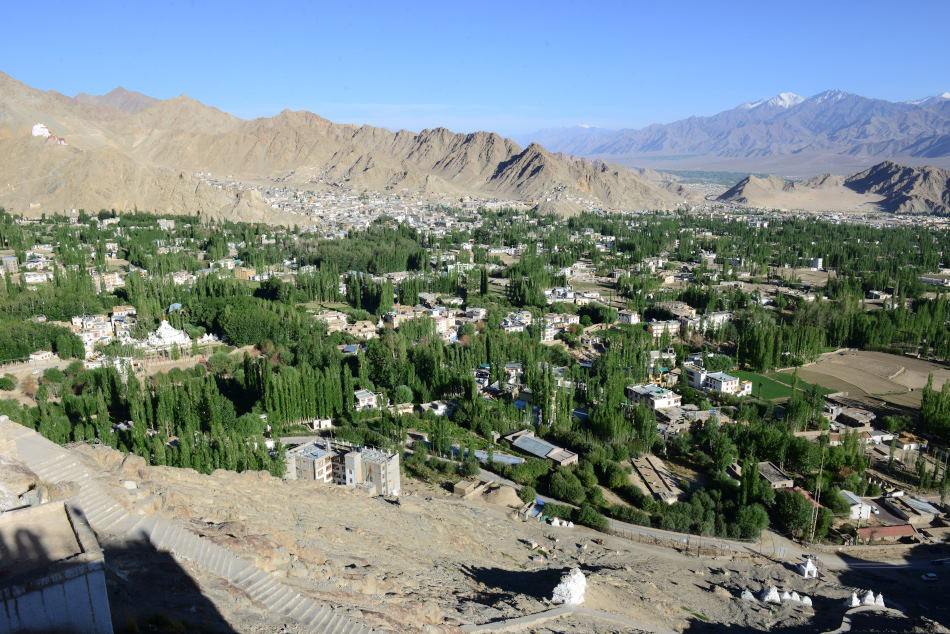 The view of Leh was dominated by the poplar trees.
The view of Leh was dominated by the poplar trees.
 The shadow of the mountain gradually expanded over the town.
The shadow of the mountain gradually expanded over the town.
 The back of Leh Palace was fully swamped in the afternoon sun.
The back of Leh Palace was fully swamped in the afternoon sun.
 The arid landscape around Leh looked drier than ever under the afternoon sun.
The arid landscape around Leh looked drier than ever under the afternoon sun.
 The steps leading down from Shanti Stupa to Changspa Road into the town centre.
The steps leading down from Shanti Stupa to Changspa Road into the town centre.
 The sun almost disappeared behind the mountain and Shanti Stupa.
The sun almost disappeared behind the mountain and Shanti Stupa.
 Visitors were still enjoying the late afternoon scenery of the Indus Valley and Stok Mountains despite evening was gradually creeping in.
Visitors were still enjoying the late afternoon scenery of the Indus Valley and Stok Mountains despite evening was gradually creeping in.
 Locals enjoying the view of Leh, with the white washed walls of Namgyal Tsemo Gompa stood out at the background.
Locals enjoying the view of Leh, with the white washed walls of Namgyal Tsemo Gompa stood out at the background.
 Shanti Stupa was completely in shade by the time we were done with the time-lapse photography.
Shanti Stupa was completely in shade by the time we were done with the time-lapse photography.
 We circled the stupa for a second time before we left.
We circled the stupa for a second time before we left.
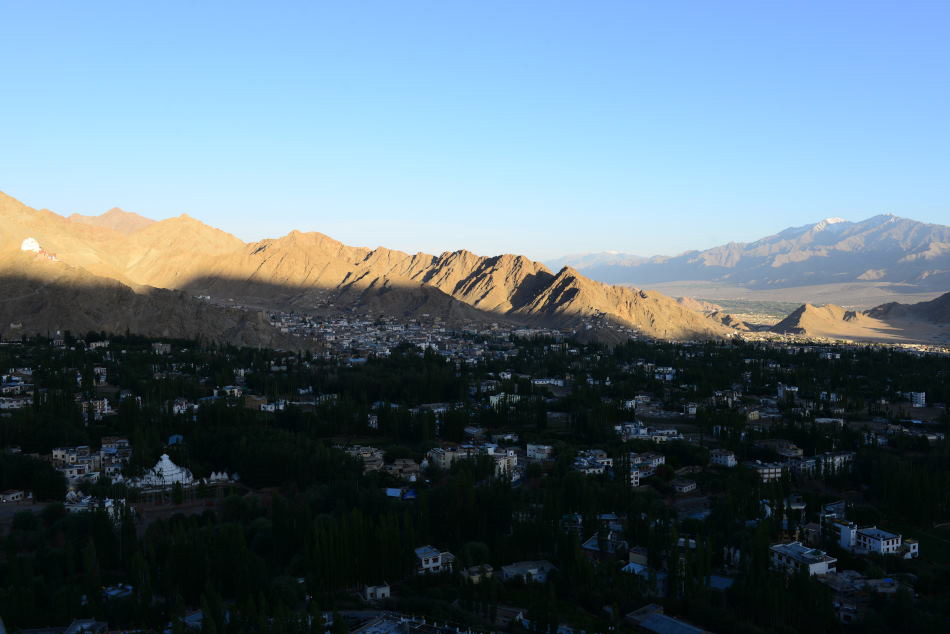 By the time we left, much of Leh was blanketed in mountain’s shadow.
By the time we left, much of Leh was blanketed in mountain’s shadow.
 We slowly walked down the steps to the town below.
We slowly walked down the steps to the town below.
 At the end of the stepped path, Changspa Road would lead us back to the centre of Leh, where we would have our last meal of Tibetan cuisine for the trip.
At the end of the stepped path, Changspa Road would lead us back to the centre of Leh, where we would have our last meal of Tibetan cuisine for the trip.
* * *
Other posts on 2016 Ladkadh & Delhi:
Introduction – LADAKH – The Land of High Passes, India
Day 1.1 – ENROUTE TO LEH, Ladakh
Day 1.2 – WALK TO MAIN BAZAAR, Leh, Ladakh
Day 1.3 – LEH PALACE, Leh, Ladakh
Day 1.4 – HOTEL LADAKH GREENS, Leh, Ladakh
Day 2.1 – NAMGYAL TSEMO GOMPA, Leh, Ladakh
Day 2.2 – LALA’S CAFE AND TIBETAN CUISINE, Leh, Ladakh
Day 2.3 – SPITUK GOMPA, Leh, Ladakh
Day 3.1 – MONASTERIES OF THE INDUS VALLEY DAY ONE, Ladakh (with map)
Day 3.2 – THIKSEY GOMPA, Indus Valley, Ladakh
Day 3.3 – CHEMREY & TAKTHOK GOMPA, Indus Valley, Ladakh
Day 3.4 – HEMIS & STAKNA GOMPA, Indus Valley, Ladakh
Day 3.5 – MATHO GOMPA & SHEY PALACE, Indus Valley, Ladakh
Day 4.1 – ON THE ROAD WEST OF LEH, Indus Valley, Ladakh
Day 4.2 – LAMAYURU GOMPA, Indus Valley, Ladakh
Day 4.3 – ALCHI & LIKIR GOMPA, Indus Valley, Ladakh
Day 4.4 – FORT ROAD IN THE EVENING, Leh, Ladakh
Day 5.1 – SHORT HIKE NEAR PHYANG, Ladakh
Day 5.2 – PHYANG VILLAGE, Ladakh
Day 5.3 – NOMADIC WOOLLEN MILLS & BON APPETIT, Leh, Ladakh
Day 6.1 – ZINGCHEN GORGE, Ladakh
Day 6.2 – SHANTI STUPA, Leh, Ladakh
Day 7.1 – LEH AIRPORT TO RED FORT, Delhi
Day 7.2 – RED FORT, Delhi
Day 7.3 – JAMA MASJID, Delhi
Day 7.4 – FAREWELL OLD DELHI, Delhi
Day 7.5 – UNITED COFFEE HOUSE, New Delhi
DAY 6: ZINGCHEN GORGE, Ladakh, India

Before the trip, we thought of doing the Markha Valley Trek, but then gave up the idea because of the lack of time. On our last day at Ladakh, the hotel manager suggested us to make a short hike to Zingchen Gorge, where many travelers started their Markha Valley Trek. Tashi again was our driver of the day. We left the hotel at around 7am. Our car headed south, passed the Spituk Gompa and continued our journey until Tashi pulled over on a country road where a lady sat below a tree. Tashi told us to get a ticket from the lady for the admission of Hemis National Park, where Zingchen Gorge was located. Soon our car drove into a desert valley of the gorge. Tashi dropped us off at the end of the road. We then crossed a bridge and entered a natural portal flanked by majestic stone cliffs to begin our half-day hike through the Zingchen Gorge.
We had no particular destination in mind, but aiming to walk as far as we could in a few hours of time. We walked leisurely on a stony road at the bottom of a rocky valley for about half an hour until reaching a local home where two donkeys were resting under a tree. From then on we walked for another hour or so on a mountain trail in the Zingchen Gorge towards the Village of Rumbak. During the hike, we crossed the river a few times via wooden bridges. After about two hours on the trail, we finally had a glimpse of the snow-capped mountains beyond the gorge. After we exited the gorge, we reached a small pile of stones and goat skulls that signified the gorge’s mouth. Further down the trail at an open area we sat by a large round pile of mani stones where we had our lunch break. After the break, we decided to head back into Zingchen Gorge to meet up with our driver Tashi. We took our time to hike back to the entrance of the gorge, and walked further down the main road until we saw Tashi and his car at Zingchen Village.
Despite short, at the last two days of our stay we had a good taste of hiking in the mountains near Leh. Hopefully in the future we would have an opportunity to do a multi-day trek in Ladakh to really experience the natural beauty of this region.
 The natural rock portal formed a perfect entrance to the Zingchen Gorge.
The natural rock portal formed a perfect entrance to the Zingchen Gorge.
 For the first half hour we were walking on a valley road.
For the first half hour we were walking on a valley road.
 The arid landscape and the greenery down at the river valley.
The arid landscape and the greenery down at the river valley.
 The surrounding landscape was extremely dry.
The surrounding landscape was extremely dry.
 We met two donkey at the end of the road.
We met two donkey at the end of the road.
 The path get narrower beyond the end of road.
The path get narrower beyond the end of road.
 Just like the other days we experienced in Ladakh, the weather in the morning and early afternoon was always sunny.
Just like the other days we experienced in Ladakh, the weather in the morning and early afternoon was always sunny.
 White khatas, prayer flags and mani stones were common at rest stops.
White khatas, prayer flags and mani stones were common at rest stops.
 After two hours of hike, we had our first glimpse of the snow-capped mountains beyond the gorge.
After two hours of hike, we had our first glimpse of the snow-capped mountains beyond the gorge.
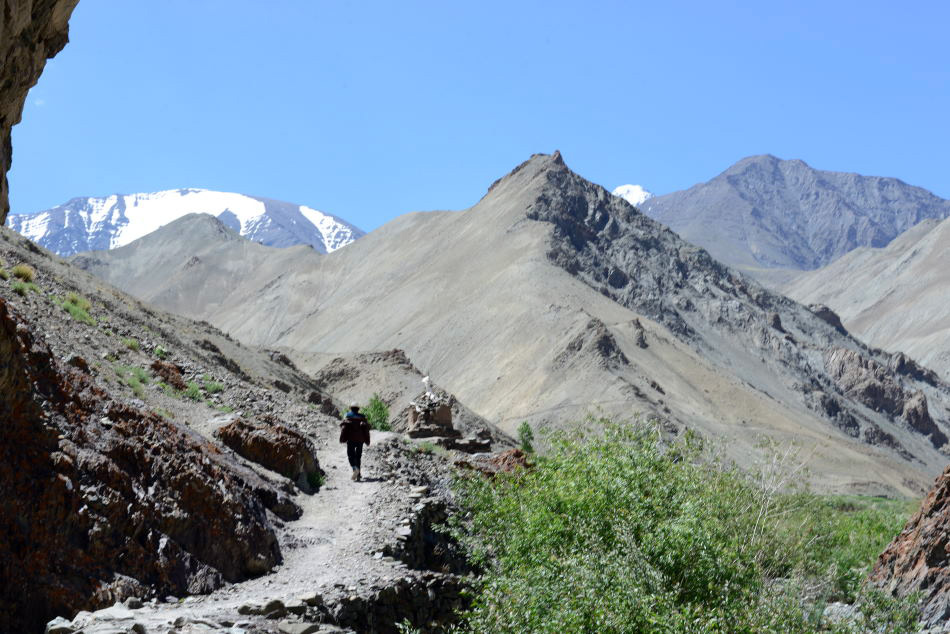 At the end of the gorge.
At the end of the gorge.
 The pile of stones and goat skull.
The pile of stones and goat skull.
 The round pile of mani stones where we had our lunch break by the river.
The round pile of mani stones where we had our lunch break by the river.
 Heading back into the gorge for our return journey.
Heading back into the gorge for our return journey.
 Impressive rock formations and wild flowers.
Impressive rock formations and wild flowers.
 Locals and their donkeys.
Locals and their donkeys.
 Wild flowers close to the gorge entrance.
Wild flowers close to the gorge entrance.
 We planned to stay for only half day in Hemis National Park. We walked as far as we could and then returned to the gorge entrance on the same route. Despite the same route, the views and experience were never the same at different times of the day. On our return, we were attracted by the rock patterns of a mountain near the gorge entrance, something that we didn’t take notice when we entered the gorge earlier in the morning.
We planned to stay for only half day in Hemis National Park. We walked as far as we could and then returned to the gorge entrance on the same route. Despite the same route, the views and experience were never the same at different times of the day. On our return, we were attracted by the rock patterns of a mountain near the gorge entrance, something that we didn’t take notice when we entered the gorge earlier in the morning.
 We were attracted by interesting rock formations during the hike.
We were attracted by interesting rock formations during the hike.
 The landscape was always dry and rocky.
The landscape was always dry and rocky.
 After 5 hours of hiking in Hemis National Park, we returned to the park entrance to meet up with our driver Tashi.
After 5 hours of hiking in Hemis National Park, we returned to the park entrance to meet up with our driver Tashi.
* * *
Other posts on 2016 Ladkadh & Delhi:
Introduction – LADAKH – The Land of High Passes, India
Day 1.1 – ENROUTE TO LEH, Ladakh
Day 1.2 – WALK TO MAIN BAZAAR, Leh, Ladakh
Day 1.3 – LEH PALACE, Leh, Ladakh
Day 1.4 – HOTEL LADAKH GREENS, Leh, Ladakh
Day 2.1 – NAMGYAL TSEMO GOMPA, Leh, Ladakh
Day 2.2 – LALA’S CAFE AND TIBETAN CUISINE, Leh, Ladakh
Day 2.3 – SPITUK GOMPA, Leh, Ladakh
Day 3.1 – MONASTERIES OF THE INDUS VALLEY DAY ONE, Ladakh (with map)
Day 3.2 – THIKSEY GOMPA, Indus Valley, Ladakh
Day 3.3 – CHEMREY & TAKTHOK GOMPA, Indus Valley, Ladakh
Day 3.4 – HEMIS & STAKNA GOMPA, Indus Valley, Ladakh
Day 3.5 – MATHO GOMPA & SHEY PALACE, Indus Valley, Ladakh
Day 4.1 – ON THE ROAD WEST OF LEH, Indus Valley, Ladakh
Day 4.2 – LAMAYURU GOMPA, Indus Valley, Ladakh
Day 4.3 – ALCHI & LIKIR GOMPA, Indus Valley, Ladakh
Day 4.4 – FORT ROAD IN THE EVENING, Leh, Ladakh
Day 5.1 – SHORT HIKE NEAR PHYANG, Ladakh
Day 5.2 – PHYANG VILLAGE, Ladakh
Day 5.3 – NOMADIC WOOLLEN MILLS & BON APPETIT, Leh, Ladakh
Day 6.1 – ZINGCHEN GORGE, Ladakh
Day 6.2 – SHANTI STUPA, Leh, Ladakh
Day 7.1 – LEH AIRPORT TO RED FORT, Delhi
Day 7.2 – RED FORT, Delhi
Day 7.3 – JAMA MASJID, Delhi
Day 7.4 – FAREWELL OLD DELHI, Delhi
Day 7.5 – UNITED COFFEE HOUSE, New Delhi
DAY 5: NOMADIC WOOLLEN MILLS & BON APPETIT, Leh, Ladakh, India
In the main bazaar of Leh, there were many stores selling pashmina goods but we were told that most of them were imported from China. We wanted to find a store which sold genuine Ladakh pashmina so we went online to do some research until we found Nomadic Woollen Mills. Different than other textile and souvenir stores that we found in town, the interior decor of Nomadic Woollen Mills was minimal and contemporary. At the time of our visit, they were setting up a workshop right next to the retail store. We met Nawang, the founder of Nomadic Woollen Mills at the store. After some leisure chat with Nawang, we were glad to learn more about the story of the store and the making of the Ladakh pashmina. With a selection of hand woven and machine-made products from the region, Nomadic Woollen Mills may easily win the hearts of pashmina lovers who come to Ladakh to look for the traditional Kashmir woolen shawls.
Another great found of the day was Bon Appetit, a French restaurant and lounge recommended by our guidebooks. The restaurant was hidden away in a lane south of the busy main street of Changspa Road. We sat at a table in the patio under the setting sun. With a view to the surrounding mountains, the warm fire from the outdoor torches brought great ambience for the evening. The restaurant’s menu was simple but we appreciate their dedication to using local and fresh ingredients. We started with a bottle of local beer and Kashmir apple juice, then came the comforting savory herb chicken and chicken kabob.
 Nomadic Woollen Mills was located on the first floor of a building with a window display facing the main bazaar.
Nomadic Woollen Mills was located on the first floor of a building with a window display facing the main bazaar.
 The interior decor of Nomadic Woollen Mills was simple and modern.
The interior decor of Nomadic Woollen Mills was simple and modern.
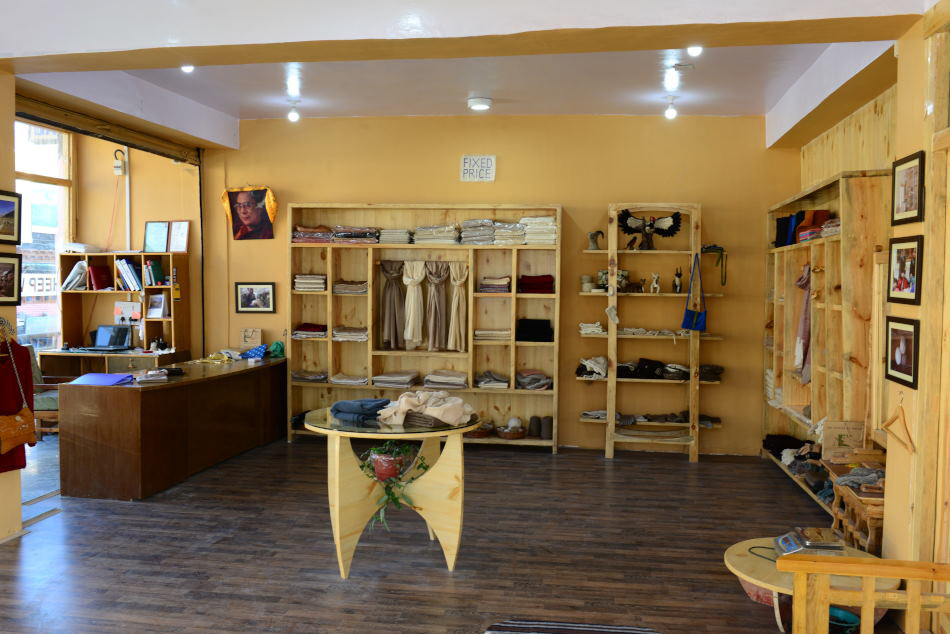 The store has a selection of both hand-woven and machine-made products.
The store has a selection of both hand-woven and machine-made products.
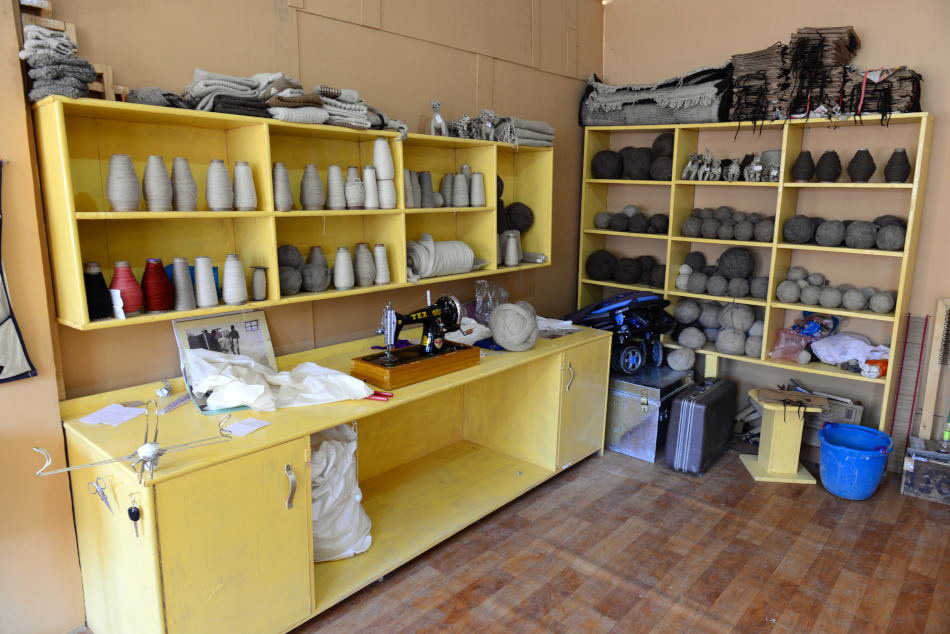 We were invited to visit the little workshop right next to the retail store.
We were invited to visit the little workshop right next to the retail store.
 The traditional weaving machine on display.
The traditional weaving machine on display.
 The outdoor patio of Bon Appetit.
The outdoor patio of Bon Appetit.
 View from the patio of Bon Appetit.
View from the patio of Bon Appetit.
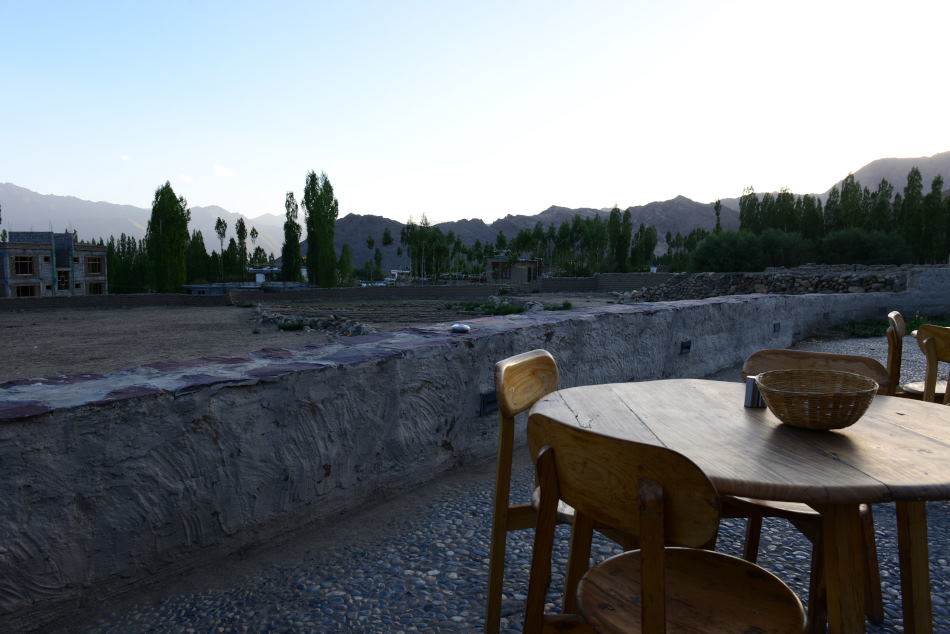 We spent a great evening at the patio of Bon Appetit.
We spent a great evening at the patio of Bon Appetit.
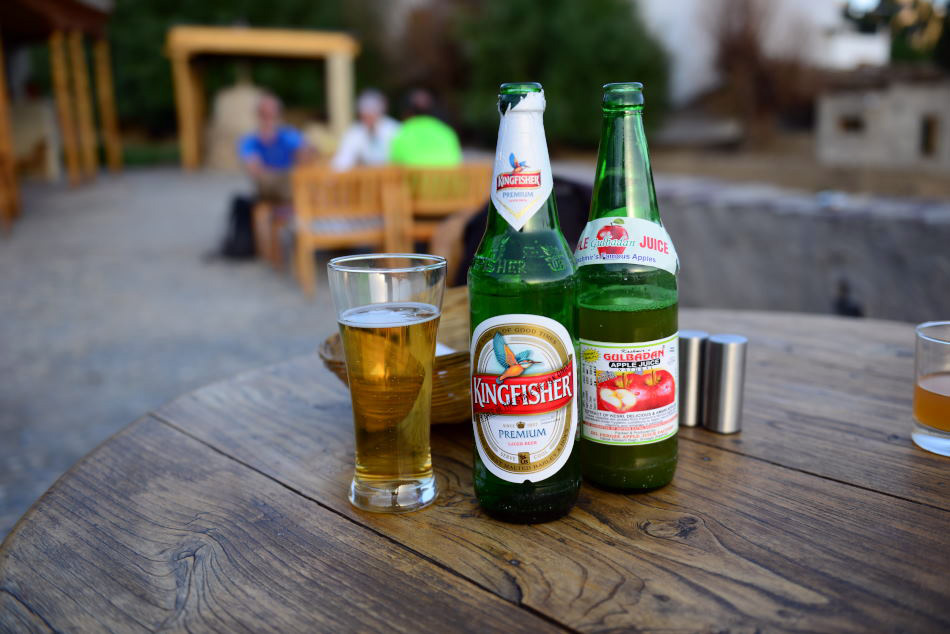 Indian beer Kingfisher and Kashmir apple juice.
Indian beer Kingfisher and Kashmir apple juice.
 Chicken with herbs.
Chicken with herbs.
 Chicken kabob.
Chicken kabob.
 As the night fell, the torches lit up the patio.
As the night fell, the torches lit up the patio.
 The clay oven for tandoori chicken at the open kitchen.
The clay oven for tandoori chicken at the open kitchen.
* * *
Other posts on 2016 Ladkadh & Delhi:
Introduction – LADAKH – The Land of High Passes, India
Day 1.1 – ENROUTE TO LEH, Ladakh
Day 1.2 – WALK TO MAIN BAZAAR, Leh, Ladakh
Day 1.3 – LEH PALACE, Leh, Ladakh
Day 1.4 – HOTEL LADAKH GREENS, Leh, Ladakh
Day 2.1 – NAMGYAL TSEMO GOMPA, Leh, Ladakh
Day 2.2 – LALA’S CAFE AND TIBETAN CUISINE, Leh, Ladakh
Day 2.3 – SPITUK GOMPA, Leh, Ladakh
Day 3.1 – MONASTERIES OF THE INDUS VALLEY DAY ONE, Ladakh (with map)
Day 3.2 – THIKSEY GOMPA, Indus Valley, Ladakh
Day 3.3 – CHEMREY & TAKTHOK GOMPA, Indus Valley, Ladakh
Day 3.4 – HEMIS & STAKNA GOMPA, Indus Valley, Ladakh
Day 3.5 – MATHO GOMPA & SHEY PALACE, Indus Valley, Ladakh
Day 4.1 – ON THE ROAD WEST OF LEH, Indus Valley, Ladakh
Day 4.2 – LAMAYURU GOMPA, Indus Valley, Ladakh
Day 4.3 – ALCHI & LIKIR GOMPA, Indus Valley, Ladakh
Day 4.4 – FORT ROAD IN THE EVENING, Leh, Ladakh
Day 5.1 – SHORT HIKE NEAR PHYANG, Ladakh
Day 5.2 – PHYANG VILLAGE, Ladakh
Day 5.3 – NOMADIC WOOLLEN MILLS & BON APPETIT, Leh, Ladakh
Day 6.1 – ZINGCHEN GORGE, Ladakh
Day 6.2 – SHANTI STUPA, Leh, Ladakh
Day 7.1 – LEH AIRPORT TO RED FORT, Delhi
Day 7.2 – RED FORT, Delhi
Day 7.3 – JAMA MASJID, Delhi
Day 7.4 – FAREWELL OLD DELHI, Delhi
Day 7.5 – UNITED COFFEE HOUSE, New Delhi
DAY 5: PHYANG VILLAGE, Ladakh, India

Our driver Tashi dropped us off at a bridge at the highest point of Phyang Village. He suggested us to walk further downhill to first visit the tiny Guru Gompa atop a rocky mount and met us at the Phyang Gompa downhill. We walked leisurely along the main road into Phyang, the village famous for the Phyang Gompa under the majestic backdrop of Mount Stok Kangri. The glacial Phyang Nullah carved a narrow river valley into the rocky landscape, extended from the highlands where we just visited down to the village. Along the nullah were terrace fields of barley, corn, rapeseed flowers, wheat and local vegetables. Occasionally the lush green fields in the middle of the valley were used as pasture plains for livestock.
We passed by several local homes and reached an open area where several stupas stood. We climbed the pathway beside the stupas up to a rocky mount where a small Buddhist shrine stood. We figured it should be the Guru Gompa. In front of Guru Gompa, there were a few dried goat horns and a colourful prayer flag. The door was locked locked and no one was around. From Guru Gompa we had a clear view of Phyang Village, Phyang Gompa and the mountain range beyond. After a quiet moment on the rocky mount, we headed back down to the main road and continued walking downhill towards Phyang Gompa. Founded in the 16th century, Phyang Gompa is one of the two monasteries in Ladakh belonged to the School of Drikung Kagyu. The lamas opened the doors of one of the prayer halls for us. We spent a short while wandering around the monastery and checked out the colourful stupas in front of the monastery. By the time we were done visiting Phyang Gompa, Tashi was already at the main parking lot waiting for us.
 Water channel led the glacial water of Phyang Nullah downhill to irrigate the farm fields of Phyang.
Water channel led the glacial water of Phyang Nullah downhill to irrigate the farm fields of Phyang.
 Terrace fields of rapeseed flowers offered a peaceful utopian setting for Phyang.
Terrace fields of rapeseed flowers offered a peaceful utopian setting for Phyang.
 Walking down the main road of Phyang Village.
Walking down the main road of Phyang Village.
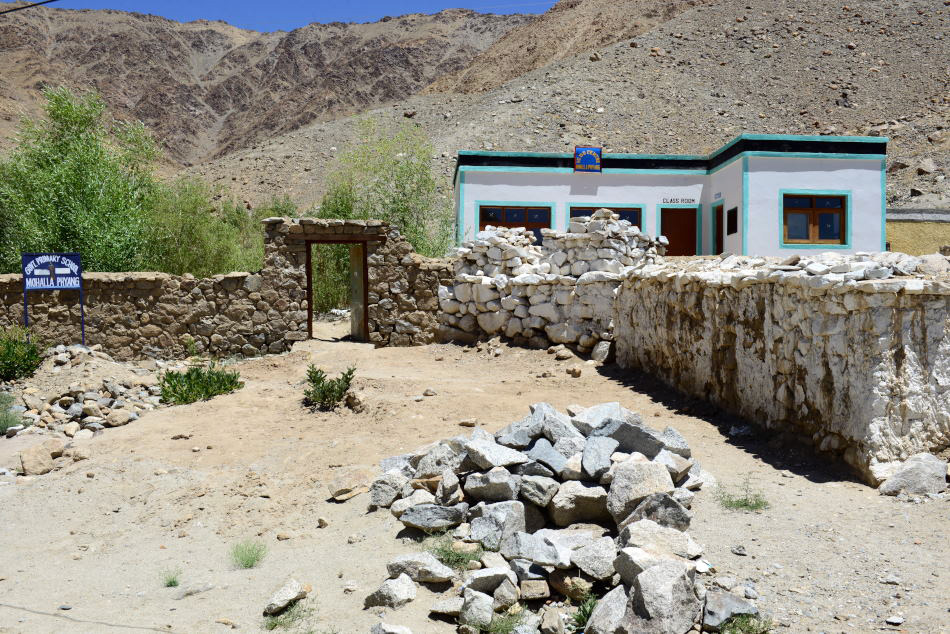 A village school at Phyang.
A village school at Phyang.
 High up on a rocky mount stood the Guru Gompa.
High up on a rocky mount stood the Guru Gompa.
 Dried goat horn by the entrance of Guru Gompa.
Dried goat horn by the entrance of Guru Gompa.
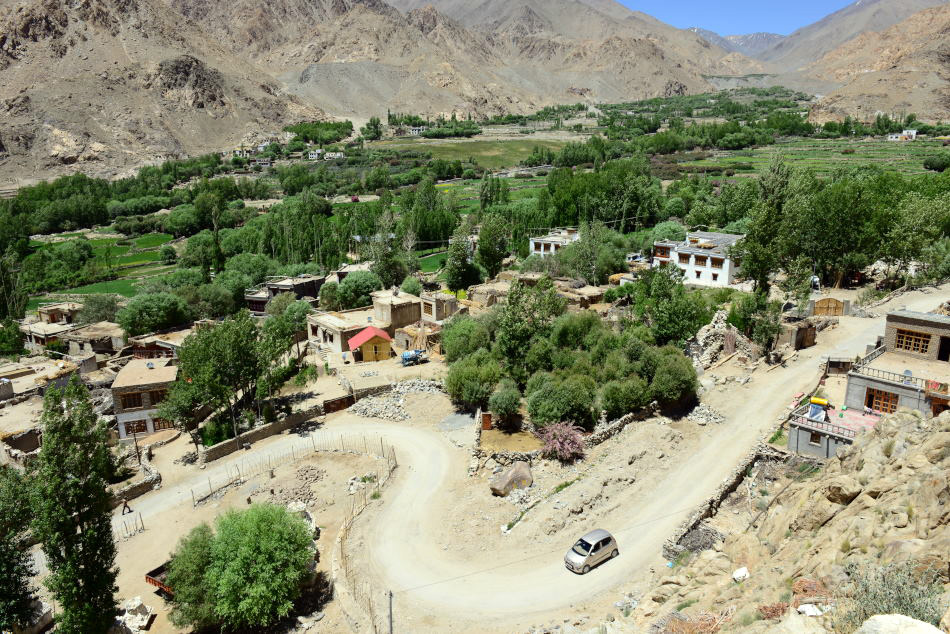 From Guru Gompa we had a clear view of the village down below and the river valley upstream.
From Guru Gompa we had a clear view of the village down below and the river valley upstream.
 Further downhill from Guru Gompa stood the famous Phyang Gompa.
Further downhill from Guru Gompa stood the famous Phyang Gompa.
 Local shepherd and livestock.
Local shepherd and livestock.
 Several green fields were used as pasture lands.
Several green fields were used as pasture lands.
 Stupas in front of the Phyang Gompa.
Stupas in front of the Phyang Gompa.
 Lamas resting after lunch break at Phyang Gompa.
Lamas resting after lunch break at Phyang Gompa.
 Young lama at a prayer wheel in Phyang Gompa.
Young lama at a prayer wheel in Phyang Gompa.
 The Phyang Gompa viewed from the stupa cluster.
The Phyang Gompa viewed from the stupa cluster.
 A cluster of colourful stupas outside of Phyang Gompa.
A cluster of colourful stupas outside of Phyang Gompa.
 View of the village from Phyang Gompa.
View of the village from Phyang Gompa.
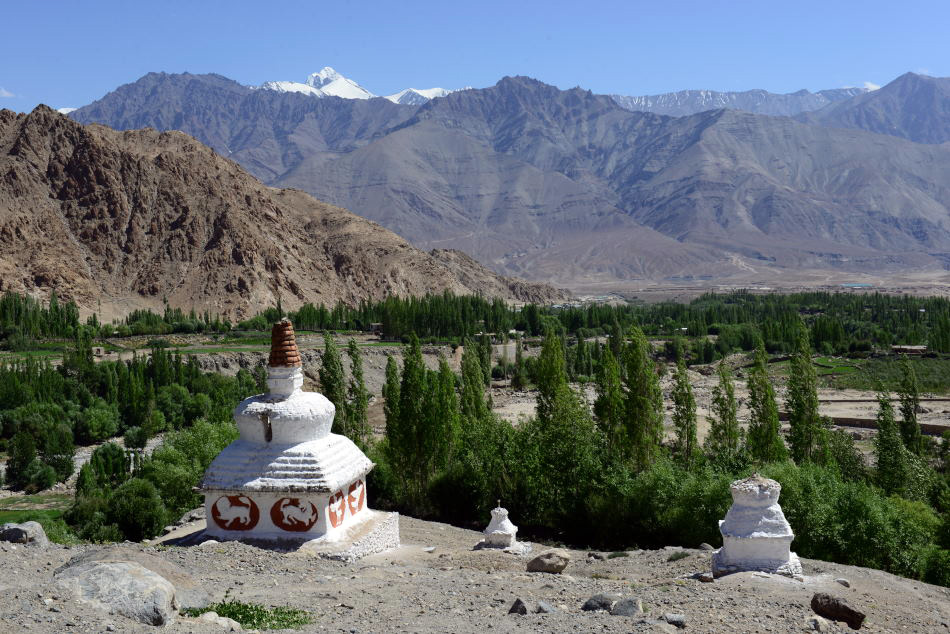 The Stok Mountain Range viewed from Phyang Gompa.
The Stok Mountain Range viewed from Phyang Gompa.
* * *
Other posts on 2016 Ladkadh & Delhi:
Introduction – LADAKH – The Land of High Passes, India
Day 1.1 – ENROUTE TO LEH, Ladakh
Day 1.2 – WALK TO MAIN BAZAAR, Leh, Ladakh
Day 1.3 – LEH PALACE, Leh, Ladakh
Day 1.4 – HOTEL LADAKH GREENS, Leh, Ladakh
Day 2.1 – NAMGYAL TSEMO GOMPA, Leh, Ladakh
Day 2.2 – LALA’S CAFE AND TIBETAN CUISINE, Leh, Ladakh
Day 2.3 – SPITUK GOMPA, Leh, Ladakh
Day 3.1 – MONASTERIES OF THE INDUS VALLEY DAY ONE, Ladakh (with map)
Day 3.2 – THIKSEY GOMPA, Indus Valley, Ladakh
Day 3.3 – CHEMREY & TAKTHOK GOMPA, Indus Valley, Ladakh
Day 3.4 – HEMIS & STAKNA GOMPA, Indus Valley, Ladakh
Day 3.5 – MATHO GOMPA & SHEY PALACE, Indus Valley, Ladakh
Day 4.1 – ON THE ROAD WEST OF LEH, Indus Valley, Ladakh
Day 4.2 – LAMAYURU GOMPA, Indus Valley, Ladakh
Day 4.3 – ALCHI & LIKIR GOMPA, Indus Valley, Ladakh
Day 4.4 – FORT ROAD IN THE EVENING, Leh, Ladakh
Day 5.1 – SHORT HIKE NEAR PHYANG, Ladakh
Day 5.2 – PHYANG VILLAGE, Ladakh
Day 5.3 – NOMADIC WOOLLEN MILLS & BON APPETIT, Leh, Ladakh
Day 6.1 – ZINGCHEN GORGE, Ladakh
Day 6.2 – SHANTI STUPA, Leh, Ladakh
Day 7.1 – LEH AIRPORT TO RED FORT, Delhi
Day 7.2 – RED FORT, Delhi
Day 7.3 – JAMA MASJID, Delhi
Day 7.4 – FAREWELL OLD DELHI, Delhi
Day 7.5 – UNITED COFFEE HOUSE, New Delhi
DAY 5: SHORT HIKE NEAR PHYANG, Ladakh, India

Originally our last two full days in Ladakh was planned for a two-day tour to the Nubra Valley on the opposite side of Khardung La Pass, one of the world’s highest pass that can be reached by car at 5,359m. Unfortunately, in the evening before our departure, we were told by the manager of Ladakh Greens Hotel that out trip to the Nubra was no longer possible. In order to visit the region near the disputed border between India and China, all travelers are required to apply for a permit. Since we were born in Hong Kong, our application was rejected by the local authorities. As a result, we had no choice but to figure something else to do for the two days. The hotel manager made a few suggested alternatives, and we picked two short hikes near Leh. Trekking is big in Ladakh but we didn’t have enough time to do a decent trek. Day hikes around Leh at least gave us a brief taste of hiking in Ladakh.
In the morning, Tashi picked us up at the hotel and drove us to Phyang, a village about 15km west of Leh. The hotel manager suggested us to start our hike at a village called Dokla, but Tashi had trouble finding the way. Instead he drove us further uphill from Phyang and stopped at a village where a few houses stood and a series of farming terraces were constructed overlooking the Stok Mountain Range. Leaving Tashi behind, we get off the car, walked through a gateway of prayer flags, and headed up a small path towards the mountains behind Phyang. We were told that the path would ultimately reach Nubra Valley in a few days’ time, where we were denied access to in the first place. We hiked past a white stupa and followed a man-made irrigation channel uphill until we saw the clear running water of a mountain stream of melted water from mountain glaciers. On a rocky mount dotted with wild flowers we sat down and had some quick snacks that the hotel chef prepared for us. Across from where we sat a few tiny singing birds flew around piles of small pebbles. After a brief stop we continued to walk uphill in the highlands near Phyang until we saw a small herd of grazing cattle from a distance upstream.
On our way back to Phyang we once again passed by the point where stream water was diverted for the irrigation system downstream. Before reaching Tashi’s car, we passed by the white stupa once again. A few people were putting fresh white paint on the stupa. We exchanged some smiles and greetings with the friendly locals before heading back to Tashi’s car. After a fine morning of hiking, Tashi suggested us to take a little break in the car while he drove us downhill to Phyang, where we could walk around the village and visit Phyang Gompa. We gladly took his suggestion.
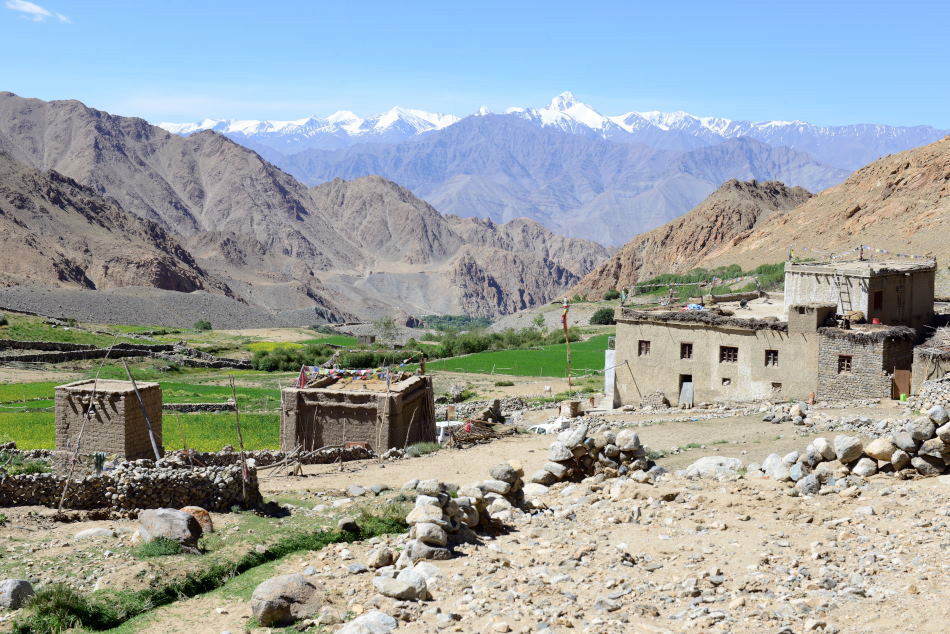 A tiny village uphill from Phyang where we started our hike. The majestic Stok Kangri and the Stok Range offered a magnificent backdrop.
A tiny village uphill from Phyang where we started our hike. The majestic Stok Kangri and the Stok Range offered a magnificent backdrop.
 Gateway of prayer flags marked the exit of the village.
Gateway of prayer flags marked the exit of the village.
 Many farming fields in the area were enclosed with low stone walls.
Many farming fields in the area were enclosed with low stone walls.
 The white stupa overlooking the village.
The white stupa overlooking the village.
 The Stok Range in a distance.
The Stok Range in a distance.
 Local agriculture is well organized by stone walls and irrigation channels.
Local agriculture is well organized by stone walls and irrigation channels.
 On the rocky mount where we had a quick snack time.
On the rocky mount where we had a quick snack time.
 Wild highland flowers stay low near the ground to avoid strong wind.
Wild highland flowers stay low near the ground to avoid strong wind.
 We kept walking uphill to follow the stream.
We kept walking uphill to follow the stream.
 The river valley continued winding through the mountains uphill.
The river valley continued winding through the mountains uphill.
 We reached a point where stream water was diverted into a small channel that fed the irrigation system downhill.
We reached a point where stream water was diverted into a small channel that fed the irrigation system downhill.
 Further uphill we saw a small herd of grazing cattle.
Further uphill we saw a small herd of grazing cattle.
 Pile of stones left by perhaps hikers or local shepherd.
Pile of stones left by perhaps hikers or local shepherd.
 Strange earth formation beyond the stone walls
Strange earth formation beyond the stone walls
 Cheerful locals doing maintenance work at the white stupa.
Cheerful locals doing maintenance work at the white stupa.
 Once again we passed by the gateway of prayer flags on our return.
Once again we passed by the gateway of prayer flags on our return.
 Close up of a prayer flag.
Close up of a prayer flag.
 On a low wall someone left a book of local text.
On a low wall someone left a book of local text.
 Not all farmlands were planted with crops, but for the ones that had they looked healthy and green despite the arid climate.
Not all farmlands were planted with crops, but for the ones that had they looked healthy and green despite the arid climate.
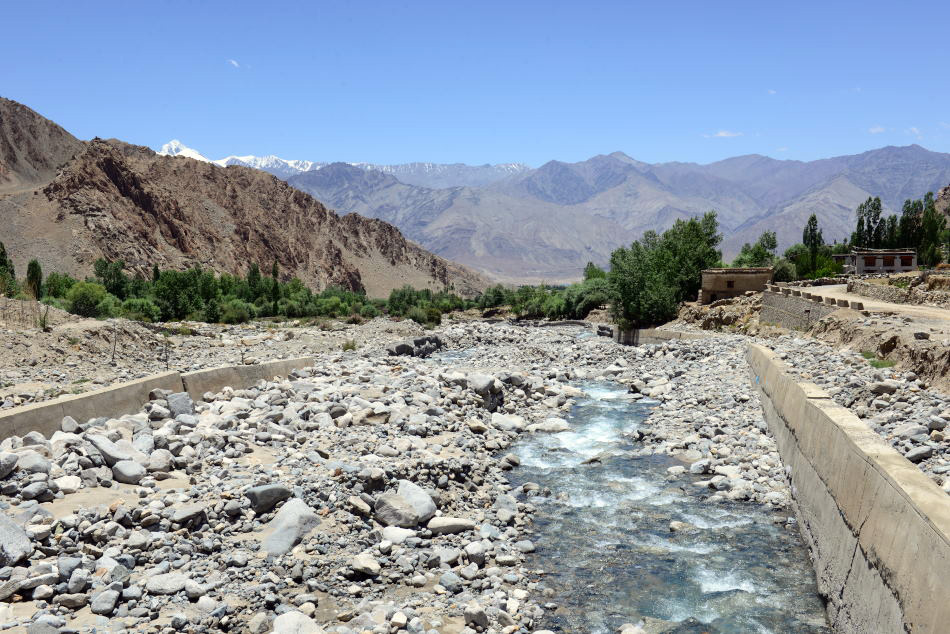 Tashi drove us downhill to Phyang and dropped us off at a bridge. We planned to wander around the village and met Tashi at the Phyang Gompa.
Tashi drove us downhill to Phyang and dropped us off at a bridge. We planned to wander around the village and met Tashi at the Phyang Gompa.
* * *
Other posts on 2016 Ladkadh & Delhi:
Introduction – LADAKH – The Land of High Passes, India
Day 1.1 – ENROUTE TO LEH, Ladakh
Day 1.2 – WALK TO MAIN BAZAAR, Leh, Ladakh
Day 1.3 – LEH PALACE, Leh, Ladakh
Day 1.4 – HOTEL LADAKH GREENS, Leh, Ladakh
Day 2.1 – NAMGYAL TSEMO GOMPA, Leh, Ladakh
Day 2.2 – LALA’S CAFE AND TIBETAN CUISINE, Leh, Ladakh
Day 2.3 – SPITUK GOMPA, Leh, Ladakh
Day 3.1 – MONASTERIES OF THE INDUS VALLEY DAY ONE, Ladakh (with map)
Day 3.2 – THIKSEY GOMPA, Indus Valley, Ladakh
Day 3.3 – CHEMREY & TAKTHOK GOMPA, Indus Valley, Ladakh
Day 3.4 – HEMIS & STAKNA GOMPA, Indus Valley, Ladakh
Day 3.5 – MATHO GOMPA & SHEY PALACE, Indus Valley, Ladakh
Day 4.1 – ON THE ROAD WEST OF LEH, Indus Valley, Ladakh
Day 4.2 – LAMAYURU GOMPA, Indus Valley, Ladakh
Day 4.3 – ALCHI & LIKIR GOMPA, Indus Valley, Ladakh
Day 4.4 – FORT ROAD IN THE EVENING, Leh, Ladakh
Day 5.1 – SHORT HIKE NEAR PHYANG, Ladakh
Day 5.2 – PHYANG VILLAGE, Ladakh
Day 5.3 – NOMADIC WOOLLEN MILLS & BON APPETIT, Leh, Ladakh
Day 6.1 – ZINGCHEN GORGE, Ladakh
Day 6.2 – SHANTI STUPA, Leh, Ladakh
Day 7.1 – LEH AIRPORT TO RED FORT, Delhi
Day 7.2 – RED FORT, Delhi
Day 7.3 – JAMA MASJID, Delhi
Day 7.4 – FAREWELL OLD DELHI, Delhi
Day 7.5 – UNITED COFFEE HOUSE, New Delhi
DAY 4: FORT ROAD IN THE EVENING, Leh, Ladakh, India

Fort Road and Changspa Road are the two main thoroughfares in Central Leh where travelers can easily find places of accommodations, restaurants and souvenir shops. For years, Changspa has long been the hub for backpackers, hippy visitors and motorcyclists. Fort Road, on the other hand, is a busy dusty road lined with newly built hotels, restaurants and souvenir shops. During our stay in Leh, Fort Road was the only access route to the city centre from our hotel. After a long day monastery visit, we would pick a restaurant at Fort Road to end the day. Tibetan Kitchen was the restaurant that we returned to after a pleasant lunch experience. At the restaurant, we had a chance to taste the complex local cuisine, which has diverse influences from Tibet, different regions of India, and even China. The best thing of all was to wash down the dishes with sips of refreshing apple juice produced from the orchards in Kashmir.
After two days of monastery hopping, we were supposed to go for a two-day trip to the Nubra Valley over the Khardung La Pass (5600m) at the other side from Leh. However, as we returned to Ladakh Greens Hotel after the long day of Lamayuru, Alchi and Likir then we realized that we had to change our travel plan at the last minute.
 A meal of Tibetan dishes at Tibetan Kitchen.
A meal of Tibetan dishes at Tibetan Kitchen.
 A bottle of apple juice made with Kashmir apples.
A bottle of apple juice made with Kashmir apples.
 The dusty Fort Road with Namgyal Tsemo Gompa on the hills at the background.
The dusty Fort Road with Namgyal Tsemo Gompa on the hills at the background.
 Souvenir shops along Fort Road.
Souvenir shops along Fort Road.
 Motorcycles and SUV were commonly seen on the dusty Fort Road.
Motorcycles and SUV were commonly seen on the dusty Fort Road.
 Shops opened till late along Fort Road.
Shops opened till late along Fort Road.
 A few open spaces along Fort Road were used as market for Tibetan handicrafts.
A few open spaces along Fort Road were used as market for Tibetan handicrafts.
 Every night we stayed in Leh, we had to walk for 20 minutes on the bumpy Fort Road, including a section without any street lamps.
Every night we stayed in Leh, we had to walk for 20 minutes on the bumpy Fort Road, including a section without any street lamps.
 Beyond the last few souvenir shops, Fort Road would be in complete darkness unless a SUV or motorcycle drove by with their lights on.
Beyond the last few souvenir shops, Fort Road would be in complete darkness unless a SUV or motorcycle drove by with their lights on.
* * *
Other posts on 2016 Ladkadh & Delhi:
Introduction – LADAKH – The Land of High Passes, India
Day 1.1 – ENROUTE TO LEH, Ladakh
Day 1.2 – WALK TO MAIN BAZAAR, Leh, Ladakh
Day 1.3 – LEH PALACE, Leh, Ladakh
Day 1.4 – HOTEL LADAKH GREENS, Leh, Ladakh
Day 2.1 – NAMGYAL TSEMO GOMPA, Leh, Ladakh
Day 2.2 – LALA’S CAFE AND TIBETAN CUISINE, Leh, Ladakh
Day 2.3 – SPITUK GOMPA, Leh, Ladakh
Day 3.1 – MONASTERIES OF THE INDUS VALLEY DAY ONE, Ladakh (with map)
Day 3.2 – THIKSEY GOMPA, Indus Valley, Ladakh
Day 3.3 – CHEMREY & TAKTHOK GOMPA, Indus Valley, Ladakh
Day 3.4 – HEMIS & STAKNA GOMPA, Indus Valley, Ladakh
Day 3.5 – MATHO GOMPA & SHEY PALACE, Indus Valley, Ladakh
Day 4.1 – ON THE ROAD WEST OF LEH, Indus Valley, Ladakh
Day 4.2 – LAMAYURU GOMPA, Indus Valley, Ladakh
Day 4.3 – ALCHI & LIKIR GOMPA, Indus Valley, Ladakh
Day 4.4 – FORT ROAD IN THE EVENING, Leh, Ladakh
Day 5.1 – SHORT HIKE NEAR PHYANG, Ladakh
Day 5.2 – PHYANG VILLAGE, Ladakh
Day 5.3 – NOMADIC WOOLLEN MILLS & BON APPETIT, Leh, Ladakh
Day 6.1 – ZINGCHEN GORGE, Ladakh
Day 6.2 – SHANTI STUPA, Leh, Ladakh
Day 7.1 – LEH AIRPORT TO RED FORT, Delhi
Day 7.2 – RED FORT, Delhi
Day 7.3 – JAMA MASJID, Delhi
Day 7.4 – FAREWELL OLD DELHI, Delhi
Day 7.5 – UNITED COFFEE HOUSE, New Delhi
DAY 4: ALCHI & LIKIR GOMPA, Indus Valley, Ladakh, India

We had high expectations for Alchi Gompa, which has long been famous for its wall paintings dated back to the 12th century. It was already past noontime when we were done with Lamayuru. By the time we reached our next destination Alchi, we couldn’t wait to sit down at the outdoor restaurant of Zimskhang Holiday Home for a quick bite. Under the shades of trees and fabric canopies, Tachi and we had a relaxing lunch of local dishes. After the meal, we entered a winding passageway and through a lane full of souvenir stalls until reaching the monastery compound. A number of centuries-old stupas decorated with colourful prayer flags flanked the monastery forecourt. There were three ancient shrines that visitors could enter and admire the wall paintings, along with the huge statues of Buddha. It was not allowed to take photographs inside the shrines. We could only admire the richly decorated halls while we were there. The Buddhist statues and interior architectural details dated back to almost a thousand years were amazing. However, many of the wall paintings were either darken over the years or were partially ruined by brutal restorations painted over the originals. There wasn’t as much to see at Alchi as we imagined before our visit. After visits of the three halls among the crowds of local tourists we decided to move on to Likir Gompa.
Situated at an relatively isolated about 10km away from the Leh-Srinigar Highway, Likir Gompa is a beautiful Tibetan Buddhist monastery of the Gelug sect founded in the 11th century. As we approach the monastery, we could see the 23m golden statue of Maitreya Buddha (Buddha of Future) from a distance. Tashi didn’t join us for our tour of the monastery as he wanted to wash the car. On our own, we first walked to the platform where the 23m Maitreya Buddha sat. Opposite from the golden plated statue stood a lama school complex. Several young lamas were playing and chasing each other at the school courtyard. Their laughter certainly lifted our spirit a little in the grey and cool afternoon. Inside Likir Gompa, we visited two assembly halls: an older hall with rolls of seating flanked by wall shelving full of ancient texts and a newer hall decorated with glossy wall thangka depicting Mahakala (a fierce looking protector deity) in various gestures. We took our time to admire the wall paintings and walk around the monastery from its rooftop to exterior platforms. By the time we returned to the entrance plaza, Tachi was done cleaning the car and ready for our return journey to Leh.
 The winding passage that led into Alchi Monastery.
The winding passage that led into Alchi Monastery.
 The twin trees marked the location of the original spot where Lama Rinchen Zangpo put his walking stick down and founded the monastery in the 10th century, so as the legend said.
The twin trees marked the location of the original spot where Lama Rinchen Zangpo put his walking stick down and founded the monastery in the 10th century, so as the legend said.
 Old timber entrance structure of Alchi’s Sumtseg (three storey building) survived to the present day.
Old timber entrance structure of Alchi’s Sumtseg (three storey building) survived to the present day.
 The ornate woodwork of the columns and the interior decorations at Alchi were created by Kashmir artists.
The ornate woodwork of the columns and the interior decorations at Alchi were created by Kashmir artists.
 Details of the entrance woodwork.
Details of the entrance woodwork.
 Entrance into one of the two shrines at a garden near the Dukhang of Alchi.
Entrance into one of the two shrines at a garden near the Dukhang of Alchi.
 The oldest stupas (chorten) at Alchi dated back as far as the 13th century.
The oldest stupas (chorten) at Alchi dated back as far as the 13th century.
 A mother and daughter at a prayer wheel at the entrance of Alchi.
A mother and daughter at a prayer wheel at the entrance of Alchi.
 We arrived at Likir in late afternoon.
We arrived at Likir in late afternoon.
 The Buddhist school complex across from the statue of Maitreya Buddha.
The Buddhist school complex across from the statue of Maitreya Buddha.
 The 23m Maitreya Buddha could be seen from far away.
The 23m Maitreya Buddha could be seen from far away.
 Entrance to one of the two main assembly hall at Likir.
Entrance to one of the two main assembly hall at Likir.
 Inside the assembly hall, yellow ropes of each lama were folded neatly on the rows of seating.
Inside the assembly hall, yellow ropes of each lama were folded neatly on the rows of seating.
 Hundreds of ancient Buddhist texts were stored in glass cabinets against the wall of the assembly hall.
Hundreds of ancient Buddhist texts were stored in glass cabinets against the wall of the assembly hall.
 Detail of an old wall painting.
Detail of an old wall painting.
 Detail of a new and glossy Mahakala wall painting at the other assembly hall.
Detail of a new and glossy Mahakala wall painting at the other assembly hall.
 Photo of Likir Gompa from distance.
Photo of Likir Gompa from distance.
 The lush green Indus River Valley below Likir.
The lush green Indus River Valley below Likir.
 The main courtyard of Likir as seen from rooftop.
The main courtyard of Likir as seen from rooftop.
 Likir wasn’t a popular destination comparing to Alchi or Lamayuru. We could hardly see any visitors in the monastery and the entrance plaza was also empty.
Likir wasn’t a popular destination comparing to Alchi or Lamayuru. We could hardly see any visitors in the monastery and the entrance plaza was also empty.
* * *
Other posts on 2016 Ladkadh & Delhi:
Introduction – LADAKH – The Land of High Passes, India
Day 1.1 – ENROUTE TO LEH, Ladakh
Day 1.2 – WALK TO MAIN BAZAAR, Leh, Ladakh
Day 1.3 – LEH PALACE, Leh, Ladakh
Day 1.4 – HOTEL LADAKH GREENS, Leh, Ladakh
Day 2.1 – NAMGYAL TSEMO GOMPA, Leh, Ladakh
Day 2.2 – LALA’S CAFE AND TIBETAN CUISINE, Leh, Ladakh
Day 2.3 – SPITUK GOMPA, Leh, Ladakh
Day 3.1 – MONASTERIES OF THE INDUS VALLEY DAY ONE, Ladakh (with map)
Day 3.2 – THIKSEY GOMPA, Indus Valley, Ladakh
Day 3.3 – CHEMREY & TAKTHOK GOMPA, Indus Valley, Ladakh
Day 3.4 – HEMIS & STAKNA GOMPA, Indus Valley, Ladakh
Day 3.5 – MATHO GOMPA & SHEY PALACE, Indus Valley, Ladakh
Day 4.1 – ON THE ROAD WEST OF LEH, Indus Valley, Ladakh
Day 4.2 – LAMAYURU GOMPA, Indus Valley, Ladakh
Day 4.3 – ALCHI & LIKIR GOMPA, Indus Valley, Ladakh
Day 4.4 – FORT ROAD IN THE EVENING, Leh, Ladakh
Day 5.1 – SHORT HIKE NEAR PHYANG, Ladakh
Day 5.2 – PHYANG VILLAGE, Ladakh
Day 5.3 – NOMADIC WOOLLEN MILLS & BON APPETIT, Leh, Ladakh
Day 6.1 – ZINGCHEN GORGE, Ladakh
Day 6.2 – SHANTI STUPA, Leh, Ladakh
Day 7.1 – LEH AIRPORT TO RED FORT, Delhi
Day 7.2 – RED FORT, Delhi
Day 7.3 – JAMA MASJID, Delhi
Day 7.4 – FAREWELL OLD DELHI, Delhi
Day 7.5 – UNITED COFFEE HOUSE, New Delhi
